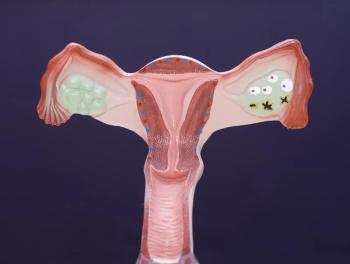
- Oncology Vol 28 No 5
- Volume 28
- Issue 5
Friend or Foe: The Bifunctional Role of Steroid Hormones in Prostate Cancer
While the multifunctional role of steroid hormones in prostate cancer and men’s health was recognized early, the apparent clinical benefit afforded by ADT tipped the scales in favor of androgen deprivation in men with advanced prostate cancer.
Nearly all men with advanced prostate cancer will receive androgen deprivation therapy (ADT) as primary treatment. Fortunately, the majority of men treated with ADT will experience objective disease response; however, these men are also likely to experience the adverse effects of ADT, such as fatigue, sexual dysfunction, decreased bone mineral density, and increased risk of cardiovascular morbidity. While the multifunctional role of steroid hormones in prostate cancer and men’s health was recognized early, the apparent clinical benefit afforded by ADT tipped the scales in favor of androgen deprivation in men with advanced prostate cancer. The recent success of novel androgen- and androgen receptor (AR)- targeted therapies such as abiraterone acetate[1,2] and enzalutamide[3,4] in castration-resistant prostate cancer (CRPC) has further validated this approach.
However, nearly all men treated with androgen- and AR-targeted therapies will eventually experience treatment resistance and disease progression; some patients exhibit primary resistance to treatment. The mechanisms associated with resistance to ADT and to the novel AR-targeted therapies have been (and continue to be) elucidated via proliferation sequence–based analyses that allow molecular characterization of individual prostate cancers; these include the induction of androgen production, AR mutations and splice variants, and truly AR-independent disease (ie, neuroendocrine phenotype).[5] Spurred by preclinical findings that testosterone may have a tumor-suppressive effect in CRPC, the potential therapeutic role of testosterone in advanced prostate cancer has regained clinical interest. In his article in this issue of ONCOLOGY, Dr. Paul Mathew summarizes the preclinical and clinical evidence that support further investigation of this approach.[6]
Most promising observations regarding the potential therapeutic role of testosterone come from preclinical models. Androgens have been shown to inhibit cell proliferation in AR-negative prostate cancer cell line models; activation of the AR in non–AR-expressing prostate cancer cells has been shown to reduce cell growth. The fact that high concentrations of testosterone have been shown to suppress splice variants in vitro is of particular relevance given the current clinical observation that AR splice variants provide a mechanism of resistance to AR-targeted therapies.
In an observation that highlights its multiple roles, the AR has been shown to act as a DNA licensing factor at origin-of-replication sites in prostate cancer cells. Importantly, progression through the cell cycle requires degradation of licensing factors, and in androgen-dependent cell lines, such as LNCaP, the AR is degraded in mitosis. In LNCaP cells grown in a low-androgen setting, there is significant overexpression of the AR. When exposed to supraphysiologic levels of testosterone, the AR is stabilized to the origin of replication and there is insufficient AR degradation; this leads to significantly increased cell death. This observation is being targeted in a clinical trial (ClinicalTrials.gov ID NCT01750398). Preliminary results of this pilot study, in which men with CRPC were treated with supraphysiologic testosterone and etoposide, demonstrate the potential clinical efficacy of this approach.[7]
Dr. Mathew then summarizes the literature available on testosterone replacement as a treatment for prostate cancer. The clinical evidence supporting the therapeutic use of testosterone, in both the hormone-sensitive and the castration-resistant settings, is limited. However, there are clinical settings in which further investigation may be warranted. One would be in patients with hormone-sensitive disease who are receiving intermittent ADT. Randomized studies so far have, at best, demonstrated the noninferiority of intermittent ADT compared with continuous ADT. In these studies, patients received ADT for a certain length of time, and then once treatment stopped, serum androgen levels presumably returned to physiologic levels over a period of time; studies have shown that time to testosterone recovery to baseline levels can be prolonged. This is not analogous to the preclinical models in which rapid cycling to supraphysiologic levels of testosterone was induced. Therefore, a more comparable approach might be one in which men receive high-dose testosterone replacement therapy during the “break” period as part of intermittent therapy.
Another setting in which additional investigation might prove fruitful-and one that is particularly timely-is in men with truly androgen- and AR-independent castration-resistant disease, since many of the most promising observations have been reported in AR-negative prostate cancer cells and those with AR mutations and splice variants. The broader clinical utilization of potent AR-targeting therapies has led to the emergence of prostate cancer with these molecular characteristics, including treatment-related neuroendocrine prostate cancer.[8] These patients have extremely poor prognoses, and novel therapeutic strategies are necessary to address this growing clinical need. Furthermore, recent work has suggested that the promiscuity of steroid hormones and of their receptors are potential mechanisms of therapeutic resistance, which further complicates our understanding.[9,10] Combined with ongoing preclinical work, efforts such as those of the Stand Up 2 Cancer-Prostate Cancer Foundation Dream Teams that promise to comprehensively elucidate the molecular landscape of advanced prostate cancer (including treatment-resistant disease) will inform future endeavors.
Financial Disclosure: Dr. Ryan receives honoraria from Janssen Biotech. Dr. Kim has no significant financial interest in or other relationship with the manufacturer of any product or provider of any service mentioned in this article.
References:
1. de Bono JS, Logothetis CJ, Molina A, et al. Abiraterone and increased survival in metastatic prostate cancer. N Engl J Med. 2011;364:1995-2005.
2. Ryan CJ, Smith MR, de Bono JS, et al. Abiraterone in metastatic prostate cancer without previous chemotherapy. N Engl J Med. 2013;368:138-48.
3. Scher HI, Fizazi K, Saad F, et al. Increased survival with enzalutamide in prostate cancer after chemotherapy. N Engl J Med. 2012;367:1187-97.
4. Beer TM, Armstrong AJ, Sternberg CN, et al. Enzalutamide in men with chemotherapy-naive metastatic prostate cancer (mCRPC): results of phase III PREVAIL study. J Clin Oncol. 2014;32(suppl 4);abstr LBA1.
5. Nelson PS. Molecular states underlying androgen receptor activation: a framework for therapeutics targeting androgen signaling in prostate cancer. J Clin Oncol. 2012;30:644-6.
6. Mathew P. The bifunctional role of steroid hormones: implications for therapy in prostate cancer. Oncology (Williston Park). 2014;28:397-404.
7. Schweizer MT, Antonarakis ES, Wang H, et al. A pilot study of supraphysiologic testosterone and oral etoposide in men with castrate-resistant prostate cancer. J Clin Oncol. 2014;32:abstr 45.
8. Beltran H, Tagawa ST, Park K, et al. Challenges in recognizing treatment-related neuroendocrine prostate cancer. J Clin Oncol. 2012;30:e386-9.
9. Arora VK, Schenkein E, Murali R, et al. Glucocorticoid receptor confers resistance to antiandrogens by bypassing androgen receptor blockade. Cell. 2013;155:1309-22.
10. Richards J, Lim AC, Hay CW, et al. Interactions of abiraterone, eplerenone, and prednisolone with wild-type and mutant androgen receptor: a rationale for increasing abiraterone exposure or combining with MDV3100. Cancer Res. 2012;72:2176-82.
Articles in this issue
over 11 years ago
Addressing the Common Mystery of the Solitary Pulmonary Noduleover 11 years ago
Leptomeningeal Enhancement in a 58-Year-Old Womanover 11 years ago
PET Imaging and Breast CancerNewsletter
Stay up to date on recent advances in the multidisciplinary approach to cancer.

















































































